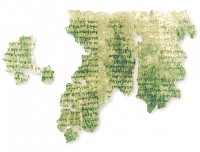1 Enoch
The First book of Enoch is one of the Old Testament pseudepigrapha, in other words, a composition attributed to a personage from the Hebrew Bible, but not included in either the Jewish or the Christian Bible.

The name "Enoch" (or Henoch) can be found in Genesis, where this patriarch is mentioned as the seventh descendant of Adam and Eve.
Jared had lived 162 years when he begat Enoch, and after he begat Enoch, he lived 800 years, and begat sons and daughters. All the days of Jared were 962 years. Then he died.
Enoch had lived 65 years when he begat Methuselah, and after he begat Methuselah, Enoch walked with God 300 years, and begat sons and daughters. All the days of Enoch were 365 years. Enoch walked with God. Then he vanished because God took him.note
Since the writer of Genesis does not write that Enoch died, but instead says that he "walked with God", later generations thought that he had seen all mysteries of the universe. From the third century BCE on, authors used him as their spokesman, attributing all sorts of secret knowledge to his revelation. Five of these texts were joined together at an unknown moment, and are now known as the First Book of Enoch. It is also called the Ethiopian Book of Enoch, because the book is best known from some forty manuscripts from Ethiopia. However, there are many Aramaic fragments of the constituent parts among the Dead Sea scrolls, a handful of Greek fragments and one scrap in Latin.
The title First Book of Enoch suggests that there is a Second Book too. This is a text on the lives of Enoch and his descendants; it is only known to us in a Slavonic translation and it is not known when it was written. The Third Book of Enoch was written in the fifth/sixth century and describes how the second-century rabbi Ishmael journeyed into heaven and saw God's throne and chariot. This work has influenced the Zohar, the sacred book of Kabbala.
Back to the First book of Enoch. It consists of five main parts, which can be subdivided. These parts were composed at different times and never meant as a unity.
- The Book of Watchers (§1-36): a third century BCE text on the Last Judgment and the reason why God will judge harshly.
- introduction (§1-5): the Last Judgment;
- narrative (§6-36): the fallen angels, their children by mortal women, the corruption of mankind, Enoch's unsuccessful intercession for the fallen angels, a vision of mankind's doom, and Enoch's journey to Earth, Hell, and Heaven.
- The Book of Similitudes (§37-71): a text from the first century CE, dealing with aspects of the Last Judgment.
- first parable: a description of heaven, where Enoch sees the habitations of the just, the angels and the Messiah (§38-44);
- second parable: a description of a.o. the Messiah, the messianic age and his judgment (§45-57);
- third parable: a description of phenomena during the Judgment by the Son of Man (§58-71).
- The Astronomical Book (§72-82): a treatise from the third century BCE on meteorology, astronomy and the calendar.
- The Book of Dream Visions (§83-90): two visions that were composed during the Maccabaean revolt (165-160 BCE).
- first vision: the Deluge as the first judgment (§83-84);
- second vision: a history of Israel until the Maccabaean revolt (§85-90).
- The Epistle of Enoch (§91-108): warnings, blessings and an apocalypse, composed in the early second century BCE.
- the Apocalypse of weeks (§91 and 93)
- woes to the sinners, adhortations to the righteous ones (§94-104)
- an appendix (§105-108)
This complex work was extremely influential and is very important. It is the oldest known Jewish apocalyptic text -older than the canonical book of Daniel- and this proves that it is incorrect to maintain that the apocalyptic genre originated in the age of the Maccabaean revolt.
The Enochic literature was very popular: there are many fragments among the Scrolls of the Dead Sea. Oddly enough, these belong to the first and last three units only; the Book of Similitudes is conspicuously absent, which may be explained from the fact that the library contained no manuscripts of compositions from the first century CE. Several copies make it clear that the Book of Watchers and the Book of the Dream Visions were already joined in c.100 BCE.
Several other pseudepigrapha refer to 1 Enoch. One may think of the Book of Jubilees and the Book of Giants, which builds on 1 Enoch. The First book of Enoch is quoted in the Christian Bible.note Its theory that the Messiah would arrive seventy generations after Enoch is assumed in the Gospel of Luke.